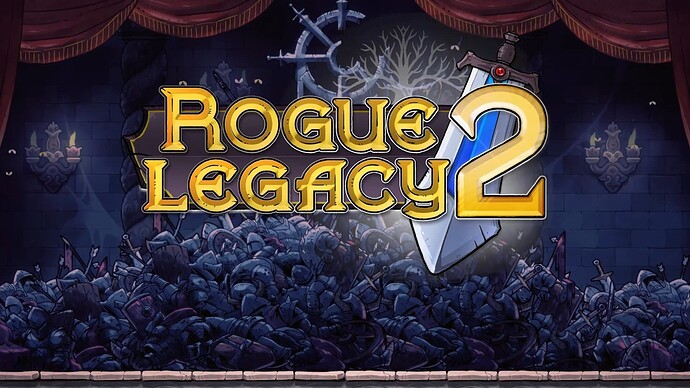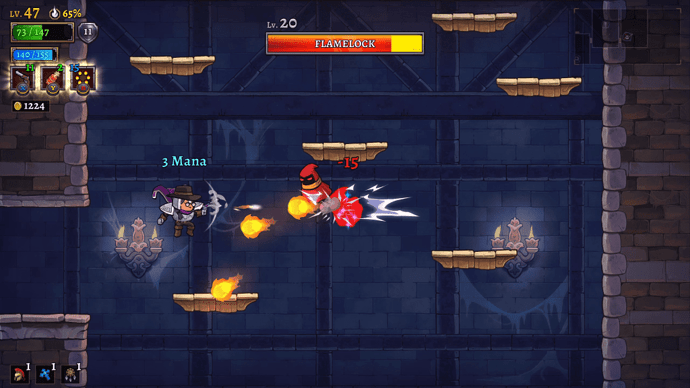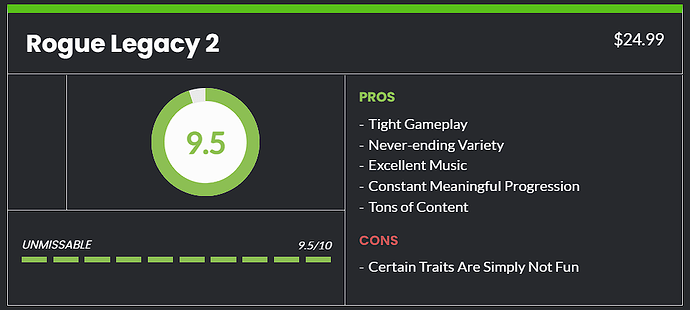Originally published at: Review | Rogue Legacy 2 - XboxEra
A follow-up to the 2013 original, Rogue Legacy 2 is everything an iterative sequel should be. It’s bigger, more finely tuned, smarter, deeper, and simply better in every way. It takes the original and sands away all the rough edges, using its nearly two years in early access to hone in on what fans of the series want with laser precision. Mixing excellent controls, tons of variety for your playable characters, more interesting and varied enemy types, and hugely beneficial quality of life changes helps this game become one of my favorites in what has already been a year filled with great titles. Rogue Legacy 2 is everything I ever wanted in a run-based action platformer.
Familial Duty
Rogue Legacy 2 follows the same path as the first title. You control a familial line that is attempting to clear out a number of bosses (six this time) to reach the endgame. Every time you die a new set of three heirs is presented with a randomly chosen set of class types that have their own unique abilities, spells, and traits. For class types, there are thirteen on hand which you unlock as you progress through the main metagame, which I’ll explain in a bit. Fifteen different spell types are available, and there are over fifty traits.
This system is the heart and soul of the game. Things start out fairly simple class-wise, but in no time you’ll unlock vastly different playing ones such as the Gunslinger or the Ronin. Spells might be the least interesting of the three but they can be incredibly powerful when matched up with certain builds. Finally, the traits can come in 0, 1, or 2 at a time and influence how a character’s run will go a lot. Negative traits are the main way to gain bonus gold gain per run and you’ll have to balance “do I want to have the entire game be black and white to make a little more cash” or “every time I kill an enemy they drop an explosive flask, but I get more gold!?!?!” each run. It’s a tried-and-true repeated system from the first game but much like the rest, it’s bigger and better implemented.
Gone are the least fun to play with traits from the first title, and in their place are things that are negatives but I felt more in control of. The only one I truly hate is pacifist, which replaces your weapon with a peace sign and you cannot deal damage in any form. It forces you into a “run through bashing crates and looking for chests” playstyle that wasn’t that fun or interesting to me but it does offer up an enormous amount of extra gold per drop. There is so much more here but it is best experienced first-hand if you’re interested in the game. The sense of discovery is awesome and growth comes quickly through the overall metagame that is outside of each run. This of course comes in the form of gaining gold and other various currencies to upgrade your town along with buying various types of gear to empower your heirs.
The -lite part of Roguelite
My favorite part of this genre is the power creep. Slowly but surely your runs become easier in multiple ways as you gain more and more stats at the profile level. Rogue Legacy 2 has my favorite version of this with an expanded upon town feature where you build up a castle by spending gold earned in the previous run. This is how you unlock almost every part of the game, though some upgrades are tied to other methods of unlocking which, again, is best found out on your own. Basic upgrades like health, armor and damage come in various forms but your town’s residents and all of the extra character classes are unlocked here as well.
Every run feels like you are growing more powerful thanks to this system. Even if I died before getting enough gold to unlock something there is a per-class experience system that unlocks bonuses while using them. Found a castle layout that you like and want to keep? Activate the engineer and you can run the same layout for as long as you’re willing to earn less gold per run. Teleporters dot the map and are part of another quality-of-life upgrade that you’ll find immensely satisfying once you unlock it. I never felt the same frustration with having to do so many of the same runs as I did with the first title. The map and tile variety is enormous but they cleverly keep you from having to go on incredibly long runs when you want to push progression in the story. By the same token when I wanted to grind out more gold to keep upgrading myself for a tough boss fight I was able to fly through previously difficult areas because of how much I had powered up at the profile level.
Many games in the genre focus on a “leveling up in your mind by getting better at the game approach”, and that is on display here as well. The difference that makes me love it so much is that it’s matched by never-ending carrot-on-a-stick numbers going up as well. For example, at the start of each run any remaining gold you give to Charon the boatman as he brings you to the castle in which you start. Eventually, you get an upgrade so that even this simple act continually adds to your character’s stats. There are so many basic systems that I never felt like I was wasting my time, and thankfully the gameplay matches all of these brilliant ideas.
Jumpin, Slashin, ‘N Dashin
The gameplay will feel instantly familiar to anyone that played the first game. A is your jump, X is your main weapon, Y is your class ability, and B is your spell. By default, the left and right triggers are your dashes in whichever direction you’re currently moving. You can swap this to the ‘classic’ option though and have LT dash left and RT dash right. Left-bumper is the kickflip ability, and it’s a brilliant move. Any in-game breakable or enemy can be bounced off of with this (and it can also be used by holding down and pressing jump). It adds a lot to the movement and is useful in avoiding damage. The right bumper is your interact button, and the d-pad is the same movement as the left stick.
Everything is built for a controller, and I would not recommend trying to play this on a mouse and keyboard if you’re on a PC. It feels incredibly tight but you need to hit so many buttons at the time often and it felt nearly impossible to play well on PC this way. For this review, I started on PC and switched to Xbox Series X once that code was ready. Performance on PC was fantastic as you would hope with the graphics on hand. The game looks great but it’s not pushing hardware that tough and could most likely be played on any decent gaming rig from the past 15 years. I was disappointed that the Series X didn’t seem to support anything more than 60fps as I routinely got 2 to 500 on my PC and it felt more responsive overall.
One of my main issues with the original is I hated some of the enemy types (I’m looking at you paintings!). There are some dastardly foes on hand here as well but I felt like the options for taking them on, especially as you progress through the upgrade path, worked far better in keeping down my frustration at death. Every time I died I knew it was my fault. It’s a game you want to play quickly because it feels so damned good, but you will be punished if you rush into everything like a bull in a China shop. Certain class types, like the Mage, are far squishier than say a Dragon Lancer but they have incredibly high damage potential with their constant mana regeneration for spell use. Eventually, you will unlock the ability to re-roll your heir choices as well.
Simplistic Beauty
As stated previously, this is a good-looking game. It’s not demanding on your hardware but the art direction is excellent and it’s clean. I never felt like my character or the environment was obfuscated in a way that was detrimental to the gameplay. Some of the traits that add on extra gold gain do this on purpose though, such as the Diva one which puts a big spotlight on your character, small spotlights on enemies, and blacks out everything else. Gone is the pixel-graphic aesthetic of the first title and in its place is a still 2D-focused but now fully modeled look that I think is a huge improvement. It reminds me a lot, style-wise, of the Cyanide and Happiness webcomics, and there is a sense of humor that permeates everything here.
The music of RL1 was some of my favorite of the last-gen, and the sequel’s soundtrack has been every bit as catchy. This is a good thing as you’ll be spending a lot of time in the same areas, listening to the same music over and over again as you work your way to each boss. All of it has been great with the main castle theme being my favorite so far. There is no voice acting but what sound effects are here are fine. The tings of hits on metal and crunches of being hit make it clear what is going on and enemy noises help you know who is in the room with you even before you’ve seen them.
The story seems a lot bigger this time with a large number of journal entries for each area that delve into the mystery and intrigue that have engulfed the castle and its surrounding lands in death and misery. Over far too many hours I ran into no bugs on either PC or Console and as stated previously performance was stellar. The time in early access seems to have been well spent as the amount of content on hand is enormous. Perhaps too enormous for those looking for a quick run-through and multiple new-game +’s like with the first game, but for me, that’s a huge bonus. I want to play this game for a very long time and between the main story, side-challenge content, and new game plus potential this title is freaking massive.
In Conclusion
Rogue Legacy 2 is excellent in every conceivable metric. The gameplay is fast, tight, and feels fair. It’s simplistic but beautiful graphically. The music is excellent, and the story is intriguing but not in the way. At $25 US this is something every fan of the genre either new or old should give a try. It takes every positive from the solid first game and improves upon it while sanding away many of its rough edges.
| Reviewed on | Xbox Series X & Windows PC |
| Available on | Xbox One, Xbox Series X|S, Windows PC |
| Release Date | April 28th, 2022 |
| Developer | Cellar Door Games |
| Publisher | Cellar Door Games |
| Rated | E for Everyone |
![Review | Rogue Legacy 2 [4K]](https://forum.xboxera.com/uploads/default/original/3X/a/5/a5ca989d76bee71c5e31cd54cf85cead6ea86904.jpeg)








